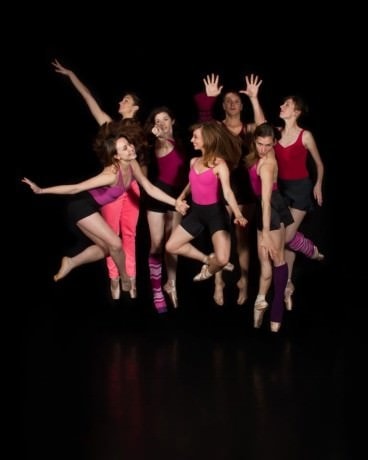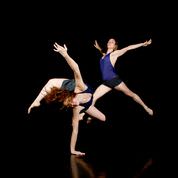MOVEiUS Dance presented Legacy: A Conversation Through Contemporary Ballet, an audience-friendly afternoon of work by multiple choreographers, yesterday as a part of the Atlas INTERSECTIONS Festival. This concert featured multiple artistic aesthetics, from classical work resembling what one automatically thinks of when they hear the word ballet, to contemporary ballet work appealing to those with more of an appreciation for the non-traditional, and deeper uses of ballet choreography and performance.
Part 1: Past was comprised of four pieces of choreography. If I had to tie these works together, thematically, I would say that they explored reflections on experiences that have already happened. The concert began with Kimberly Parmer’s work Reminiscence, a beautiful work for seven dancers in black and nude rhinestone encrusted dresses. Parmer utilized different colors of light on the cyc at the back of the stage to reflect the mood of the specific section of Johann Sebastian Bach’s music. The piece began with a soloist “reliving” something, as if memories were flooding her mind, and dancers in two columns at the sides of the stage echoed different movements as she danced them. As the piece developed, dancers performed similar movement phrases at differing speeds, representing isolated memories.
Also in this section of the concert was The Sun is Not Sinking, choreographed by Katya Vasilaky on four dancers, with a beautifully resistant movement quality, echoing the musical styling of Schubert. The dancers really carved through the space with every movement. The piece utilized a solo figure to illustrate the freedom of the solo, and the soloist was displaced and moved out of the way in group sections, illustrating displacement in a group dynamic.
Eclosion, choreographed and performed by Junichi Fukuda and set to Olivier Bensa’s La grande terre, followed Vasilaky’s work. Fukuda’s use of repetition and the perimeter of the stage space were hypnotizing, as he jogged his memory and certain moments stuck out more than others for him before our eyes. The juxtaposition of his athletic movement phrases with his hands in his pockets and an inward focus was beautiful. His movement walked the line between frenetic and minimal, and perfectly mirrored the music.
Legacy, choreographed by Diana Movius (the producer and director of MOVEiUS Dance), closed out the Past section of the concert, set to the emotionally stirring music of Arvo Part. The first piece performed en pointe in the concert, Legacy felt like the bridge from the state of affairs of the past to the status quo. In order to understand what is happening in the present, the audience had to see what the past was like. Movius perfectly echoed the instrumental depth and volume of the music with the number of dancers in each section. There was efficiency to the flow from solos to duets, trios and quartets that amplified the contrast from pulsating string themes to dream-like melodious themes.
The final three pieces in the concert, Part II: Future felt more in the moment. The dancers in these pieces were experiencing something before our eyes, as opposed to the first section of the concert. Verge, choreographed by Florian Rouiller and performed by Kathleen Howard en pointe, was a study of calculated aggression set to a passionate piece of music by Gotan Project. With her hair down, and a red leotard, Howard permeated the space with a ferocity that could only be matched by the fiery red cyc behind her. Profondeur Inconnue was also choreographed by Florian Rouiller, and was performed barefoot by Rouiller and Vasilasky (who choreographed The Sun is Not Sinking). These two dancers performed an underwater, futuristic duet, illustrating a futuristic environment that the audience was experiencing for the very first time. Vasilasky and Rouiller exhibited great control and release in their counter-balancing and a sinewy and supple one-ness that comes from meticulous rehearsal. Their fluidity was mesmerizing.
The concert ended with Movius’ Obsidian, which felt like the only true conversation of the show. The piece presented a classical structure of two soloists, two demi-soloists, and a corps of five dancers all en pointe, but the choreography felt like a conversation between Movius’ classical training and contemporary sensibility. Every so often, Movius injected a classical stage picture with a contemporary twist, and her movement was playfully balletic, with a turned-in passé and a non-traditional set of arm movements throughout. Obsidian felt like the right note to on which to end Legacy: A Conversation Through Contemporary Ballet.
Whether you are a ballet enthusiast or know very little beyond pointe shoes and tutus, MOVEiUS Dance is the company for you. Their blend of contemporary and classical aesthetics leads me to believe that they present something for everyone, and their athletic, charismatic, and proficient company of dancers will dazzle and entertain you until the final bow.
Run Time: One hour, with no intermission.
Legacy: A Conversation Through Contemporary Ballet played February 24, 2013 at the Atlas Performing Arts Center – 1333 H St NE, in Washington DC. Tickets for upcoming INTERSECTIONS shows can be purchased online. For more information about MOVEiUS Dance, visit their website, and follow them on Twitter @MOVEius.
LINK:
A preview of Legacy: A Conversation Through Contemporary Ballet.
https://youtu.be/9a9AZ5V35TQ






